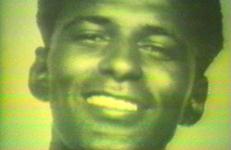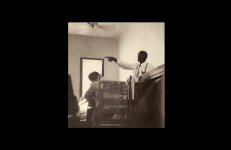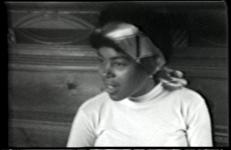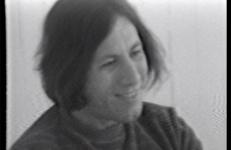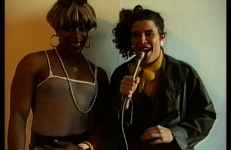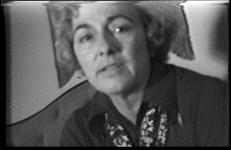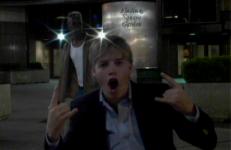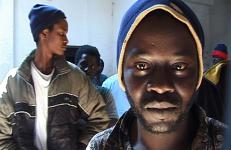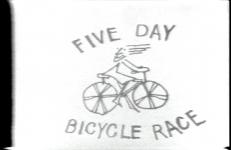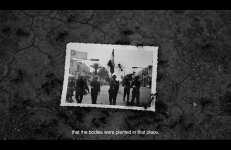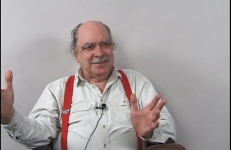Anthony Ramos' astute deconstruction of television news focuses on his part in the media coverage of President Jimmy Carter's 1977 declaration of amnesty for Vietnam draft evaders. Ramos, who had served an 18-month prison sentence for draft evasion, was interviewed by news reporter Gabe Pressman, whose film crew meets Ramos' video crew in a confrontation between technologies and sensibilities. At the time, some broadcast television news crews still used 16mm film, although the expensive transition to ENG (electronic news gathering) systems had begun in 1974.
Journalism
Animated Contingencies is an animated documentary that looks at how sketches take the place of photography in courtroom settings. Andrews focuses on how two different representations, a photograph and a courtroom sketch, capture the moment Moses Wright, Emmett Till's uncle, pointed out Till's murders while on the witness stand at their trial. The work then examines the authority of photographic evidence and how animated representations can provide both visibility and anonymity in testimony and other contexts.
In October 1969, the Videofreex visited the home of wealthy political and social activist, Lucy Montgomery, as she was hosting the Black Panther Party of Chicago during one of their most fraught times – the period just after Chairman Bobby Seale was wrongfully imprisoned for inciting riots at the Democratic National Convention a year earlier. This video documents an interview with the wife of Bobby Seale, Artie Seale.
In this tape, the Videofreex record their visit with Dr. Eugene Schoenfeld, then recognized widely for his popular medical advice column, Dear Dr. Hip Pocrates, which doled out information about sex and drugs. At the time of this session in November 1969, Schoenfeld had recently published a book based on his advice column, and was also serving as a member of the editorial board of Modern Medicine.
Hokey Sapp Does SPEW features Kate Schechter performing her invented media personality Hokey Sapp interviewing some of the luminaries at SPEW: The Homographic Convergence, a queer zine convention hosted by Randolph Street Gallery in Chicago in May, 1991. SPEW brought together artists, writers, editors of zines, performers, video-makers, activists, and bands from throughout the US and Canada, and marked the explosion of queercore subcultures through unabashed fashion, outrageous politics, humor, and joy.
In October 1969, the Videofreex visited the home of wealthy political and social activist, Lucy Montgomery, as she was hosting the Black Panther Party of Chicago during one of their most fraught times — the period just after Chairman Bobby Seale was wrongfully imprisoned for inciting riots at the Democratic National Convention a year earlier. This particular video documents a discussion with Lucy Montgomery herself interviewed by David Cort, one of the Videofreex.
In October 1969, the Videofreex visited the home of wealthy political and social activist, Lucy Montgomery, as she was hosting the Black Panther Party of Chicago during one of their most fraught times – the period just after Chairman Bobby Seale was wrongfully imprisoned for inciting riots at the Democratic National Convention a year earlier. This video documents an interview with the wife of Bobby Seale, Artie Seale. The video opens with a statement by Mrs.
While out shooting for a different project altogether, I encountered two sleeping men on a Manhattan street. A short time later, I was standing in front of Pennsylvania Train Station with the camera on a tripod, when one of the men suddenly reappeared. He stepped in front of my camera and began to speak, about his path in the U.S. military, from Panama to Afghanistan to Iraq, about his life. I decided to limit the piece to what I shot in that area in those few hours, with one key addition: the text from a classic children's rhyme.
–Jem Cohen
Set in Charlottesville during the early 1990s, an aspiring writer finalizes stories for the latest issue of Pride, a student-run newspaper at the University of Virginia. Over a hectic two-day period, she puts the finishing touches on the upcoming issue.
This title is only available on Can You Move Like This: Black Fire.
Set in Charlottesville during the early 1990s, an aspiring writer finalizes stories for the latest issue of Pride, a student-run newspaper at the University of Virginia. Over a hectic two-day period, she puts the finishing touches on the upcoming issue.
This title is only available on Can You Move Like This: Black Fire.
Sahara Chronicle encompasses an undefined number of short videos documenting the present sub-Saharan exodus towards Europe. Taking a close look at the modalities and logistics of the migration system in the Sahara, the project examines the politics of mobility, visibility and containment which lie at the heart of current global geopolitics. The material is gathered during three field trips to major gates and nodes of the trans-Saharan network in Morocco, Mauritania and Niger where migratory intensity is bundled. No voice-over narrative strings these stories together.
A collage of informal interviews and short clips, this collection of material comes from guerilla TV excursions at the 1976 Democratic National Convention. Conducted off hand, usually amidst crowds of other journalists, the footage oscillates between slight antagonisms, genuine interest, and tongue-in-cheek play. The sheer breadth of participants being engaged with, however, is quite impressive as the soon-to-be First Lady, Jesse Jackson, David Dellinger, Bella Abzug and Jerry Brown all make appearances.
Radio reports analyze staged photographs we do not see, showing the victims of a mass murder committed by Mexican soldiers. The politicization of the film accounts for the duality between framing and mis-framing, and also shows the overflowing character of a process of transit.
X-Mission explores the logic of the refugee camp as one of the oldest extra-territorial zones. Taking the Palestinian refugee camp as a case in point, the video engages with the different discourses — legal, symbolic, urban, historical — that give meaning to this exceptional space.
In this interview, communications theorist, Gene Youngblood (b. 1942) maps out the various stages of the development of video technology and its philosophical implications for human interaction. The range of topics discussed moves beyond video to offer an extensive and rich survey of American culture from the 1960s to the present moment. In addition to discussing his canonical text, Expanded Cinema, Youngblood shares stories from his early days as a police reporter for the Los Angeles Herald Examiner, where he gained intimate knowledge of the media’s politics of representation. With the acuity of hindsight, Youngblood discusses important self-discoveries, and his life-changing decision to move from the mainstream media into the world of the underground press.




